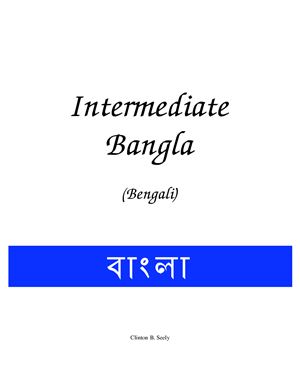Seely C.B. Intermediate Bangla. - 2006. - 386 p.
Intermediate Bangla is aimed at native English-speaking students of the Bangla language who have completed An Introduction to Bengali: Part I, by Edward C. Dimock, Jr. , Somdev Bhattacharji, and Suhas Chatterjee (2nd printing; New Delhi: Manohar, 1976) and An Introduction to Bengali: Part II, by Somdev Bhattacharji (reprinted; Chicago, 1988). I take for granted that the material presented in those two books has been leaed already. An alteative to the two introductory volumes is Bengali: A Complete Course for Beginners (Teach Yourself Books), by William Radice (London: Hodder & Stoughton, 1994).
Intermediate Bangla could be used profitably during the second year of language study in conjunction with A Bengali Prose Reader (for Second-Year Students), by Edward C. Dimock, Jr. and Somdev Bhattacharji (reprinted, Chicago, 1988). In the third year, most students would do well to read diverse selections of Bangla writing such as those presented in parts two and three of An Advanced Course in Bengali, by Eest Bender and Theodore Riccardi, Jr. (Philadelphia: South Asia Regional Studies; University of Pennsylvania, 1978). Knowledge of the grammar covered in Intermediate Bangla will enhance the student's comprehension of those readings and should increase his/her reading speed. I drew heavily upon material in An Advanced Course in Bengali for examples of the grammatical points covered in Intermediate Bangla. Both second- and third-year students would benefit immensely from Bengali Reference Grammar, by W.L. Smith (Stockholm: Association of Oriental Studies, 1997).
Each of the twenty lessons in Intermediate Bangla is divided into four sections: a short selection of Bangla; two grammar sections; and useful information in or about the language. Lesson 1 is an exception to that patte; it has been designed primarily as a review of features of the written language, including spelling and punctuation, and of pronunciation of spoken Bangla. In all the lessons, I have tried to give illustrative phrases or sentences for grammar points drawn from published Bangla texts. The reader will notice a number of quotations are attributed to "Anon. " Long before I began writing this book, I had been gathering material to use in my Bangla courses. I did not always note the author of those passages as I was making my collections for class. Consequently, when I came to cite them in this book, I found myself unable to provide with certainly the author's name for many of those passages, and thus I attribute them to "Anon. " There is one writer whose work I have cited often and to whom I would like to give explicit credit and special thanks. Ketaki Kushari Dyson, accomplished author in both English and Bangla, provided me with numerous and wonderful specimens of the language, through her much acclaimed play rAetr frod (Kolkata: Dey's, 1997).
Intermediate Bangla is aimed at native English-speaking students of the Bangla language who have completed An Introduction to Bengali: Part I, by Edward C. Dimock, Jr. , Somdev Bhattacharji, and Suhas Chatterjee (2nd printing; New Delhi: Manohar, 1976) and An Introduction to Bengali: Part II, by Somdev Bhattacharji (reprinted; Chicago, 1988). I take for granted that the material presented in those two books has been leaed already. An alteative to the two introductory volumes is Bengali: A Complete Course for Beginners (Teach Yourself Books), by William Radice (London: Hodder & Stoughton, 1994).
Intermediate Bangla could be used profitably during the second year of language study in conjunction with A Bengali Prose Reader (for Second-Year Students), by Edward C. Dimock, Jr. and Somdev Bhattacharji (reprinted, Chicago, 1988). In the third year, most students would do well to read diverse selections of Bangla writing such as those presented in parts two and three of An Advanced Course in Bengali, by Eest Bender and Theodore Riccardi, Jr. (Philadelphia: South Asia Regional Studies; University of Pennsylvania, 1978). Knowledge of the grammar covered in Intermediate Bangla will enhance the student's comprehension of those readings and should increase his/her reading speed. I drew heavily upon material in An Advanced Course in Bengali for examples of the grammatical points covered in Intermediate Bangla. Both second- and third-year students would benefit immensely from Bengali Reference Grammar, by W.L. Smith (Stockholm: Association of Oriental Studies, 1997).
Each of the twenty lessons in Intermediate Bangla is divided into four sections: a short selection of Bangla; two grammar sections; and useful information in or about the language. Lesson 1 is an exception to that patte; it has been designed primarily as a review of features of the written language, including spelling and punctuation, and of pronunciation of spoken Bangla. In all the lessons, I have tried to give illustrative phrases or sentences for grammar points drawn from published Bangla texts. The reader will notice a number of quotations are attributed to "Anon. " Long before I began writing this book, I had been gathering material to use in my Bangla courses. I did not always note the author of those passages as I was making my collections for class. Consequently, when I came to cite them in this book, I found myself unable to provide with certainly the author's name for many of those passages, and thus I attribute them to "Anon. " There is one writer whose work I have cited often and to whom I would like to give explicit credit and special thanks. Ketaki Kushari Dyson, accomplished author in both English and Bangla, provided me with numerous and wonderful specimens of the language, through her much acclaimed play rAetr frod (Kolkata: Dey's, 1997).

